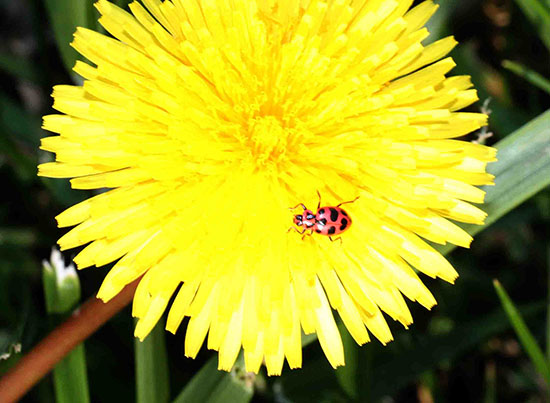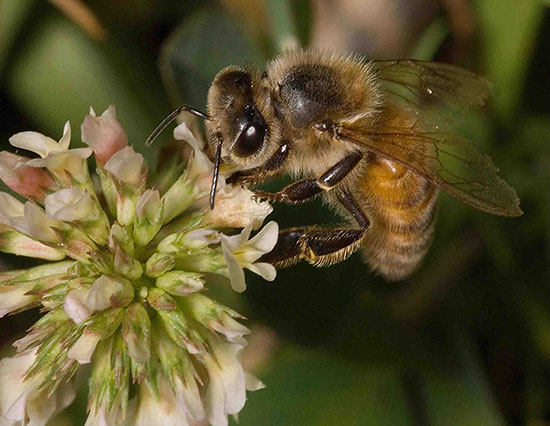Issue 17, October 16, 2017
Pollinator Protection in Turfgrass
The National Turfgrass Insect Workshop is an opportunity for university entomologists in the area of turfgrass insect research and extension to meet about every 18 months. At the most recent conference in August 2016, it was decided that representatives of the group would generate guidelines on the use of turfgrass insecticides to help protect pollinating insects. The result of that effort was published earlier this year as Best Management Practices for Turf Care and Pollinator Conservation by the North Central IPM Center. It is available as https://ncipmc.org/action/bmpturf.pdf. An excerpt of this publication follows.
Insecticides have been a focal point for concerns regarding pollinator decline, in particular the neonicotinoid class (including imidacloprid). Insecticides can have negative lethal or sub-lethal effects on pollinators, underscoring the need to be sure to always follow label precautions. This will include instructions for irrigating products to increase below ground efficacy and also remove residues from foraging zones of pollinating insects.
While turf itself may not bloom, flowering weeds are common in turf areas and are attractive to a wide variety of pollinating insects. If these weeds are present when applications are made, a scenario could arise where pollinators are harmed. To avoid direct contamination of flowering weeds in turf simply mow the flower heads of weeds like white clover, dandelion, bird's foot trefoil, etc. before treatment. If the insecticide label dictates you should not mow before treatment, follow-up the application with mowing to remove contaminated flowers. Controlling weeds with herbicides before insecticides are applied is another way to avoid direct insecticide contamination scenarios. There are other variables to consider before making an application though, such as the timing of the application, which formulation should be chosen, and which insecticide class to use.

Spotted lady beetle adult on dandelion.
In terms of seasonal timing, most insecticide applications in turf are made as preventative sprays between March and June. Unfortunately, this timing coincides with the blooming of flowering weeds and also the emergence of several species of pollinators. If turf managers can wait until May or June to make applications they can avoid exposing many pollinating insects.
Managers can also adjust the time of day for insecticide applications. Since pollinators are typically most actively foraging during the middle of the day, consider restricting applications to the early morning or the late evening.
Turfgrass insecticides can be applied in various formulations but are mainly applied as granules or liquids. There are significant differences between these formulations and their effects on pollinating insects. In a study comparing neonicotinoid liquid sprays to their granular counterparts, when applied to flowering weeds in a turf setting, it was found that granular applications pose a reduced risk to pollinating insects. While both liquid and granular products are systemic, granular products rarely directly contaminate the flowering portions of blooming plants.
If a manager is trying to control below ground pests with a neonicotinoid, granules will accomplish this with reduced hazard to pollinators. While liquid formulations could pose more of a hazard by contaminating floral resources present at the time of application, this negative interaction can be avoided through irrigation or removal of flowering weeds with mowing or herbicide applications prior-to or post-bloom.
Certain insecticide classes better target certain pests, e.g. neonicotinoids being used for soil-dwelling white grubs or pyrethroids for leaf zone pests such as chinch bugs and caterpillars. Many classes, such as the neonicotinoids, pyrethroids, and carbamates, have documented negative effects on pollinating insects. Chlorantraniliprole, part of the newer anthranilic diamide class of chemistry, can control many of the same pests that are targeted with neonicotinoids and pyrethroids including white grubs, caterpillars, and billbugs. However, it does not have any documented effects on pollinating insects and may be a good fit for industry initiatives to reduce the impacts of turf and landscape management on pollinators.
Habitat loss is one of the main drivers behind pollinator decline. To help combat this problem turf managers can promote pollinator food resources and nesting habitats by creating pollinator sanctuary plots or naturalized areas. Depending on the type of turf area there will be different ways of creating forage for pollinating insects.
Golf course managers and golf organizations such as the United States Golf Association (USGA) are actively increasing the acreage of natural habitats in out of play areas on golf courses. Initiatives like the Audubon Cooperative Sanctuary Program, Wildlife Links Program, Operation Pollinator, and the Golf and the Environment Initiative have all demonstrated that golf courses can provide a quality golfing experience while also serving as urban wildlife conservation areas.
One study found that Operation Pollinator plots attracted 51 unique bee species and identified wildflower species that were the most successful at attracting pollinators for their climatic area; New England aster, bergamot, black-eyed Susan, purple coneflower, plains coreopsis, prairie coneflower, and lanceleaf coreopsis.

Honey bee adult on white Dutch clover.
Superintendents and turf managers who are interested in establishing pollinator conservation plots should consult their local University Extension service to learn more about matching flowers with their climatic zone and should consult sources such as the Xerces Society or Pollinator Partnership for establishment advice.
Homeowners who have an interest in pollination conservation can plant their own Operation Pollinator style conservation plots or can take steps to make their yard and landscape more hospitable to these important invertebrates. While highly managed, typical turf lawns offer few foraging resources for pollinators, many lawns contain some flowering weeds such as white clover, Trifolium repens (Fabaceae), or common dandelion, Taraxacum officinale (Asteraceae). Deemed undesirable by some, these weeds represent a under recognized food source for pollinating insects.
A 2014 study found that over 50 different species of pollinators visited these weeds and that urban pollinators rely on white clover as an important food source. Lawns that include rather than exclude clover are already being promoted due to their ability to withstand drought and the natural fertilization that comes from clover. Increased awareness of pollinator interactions with white clover may increase the acceptance of these plants in turf settings. (Phil Nixon)
Author:
Phil Nixon